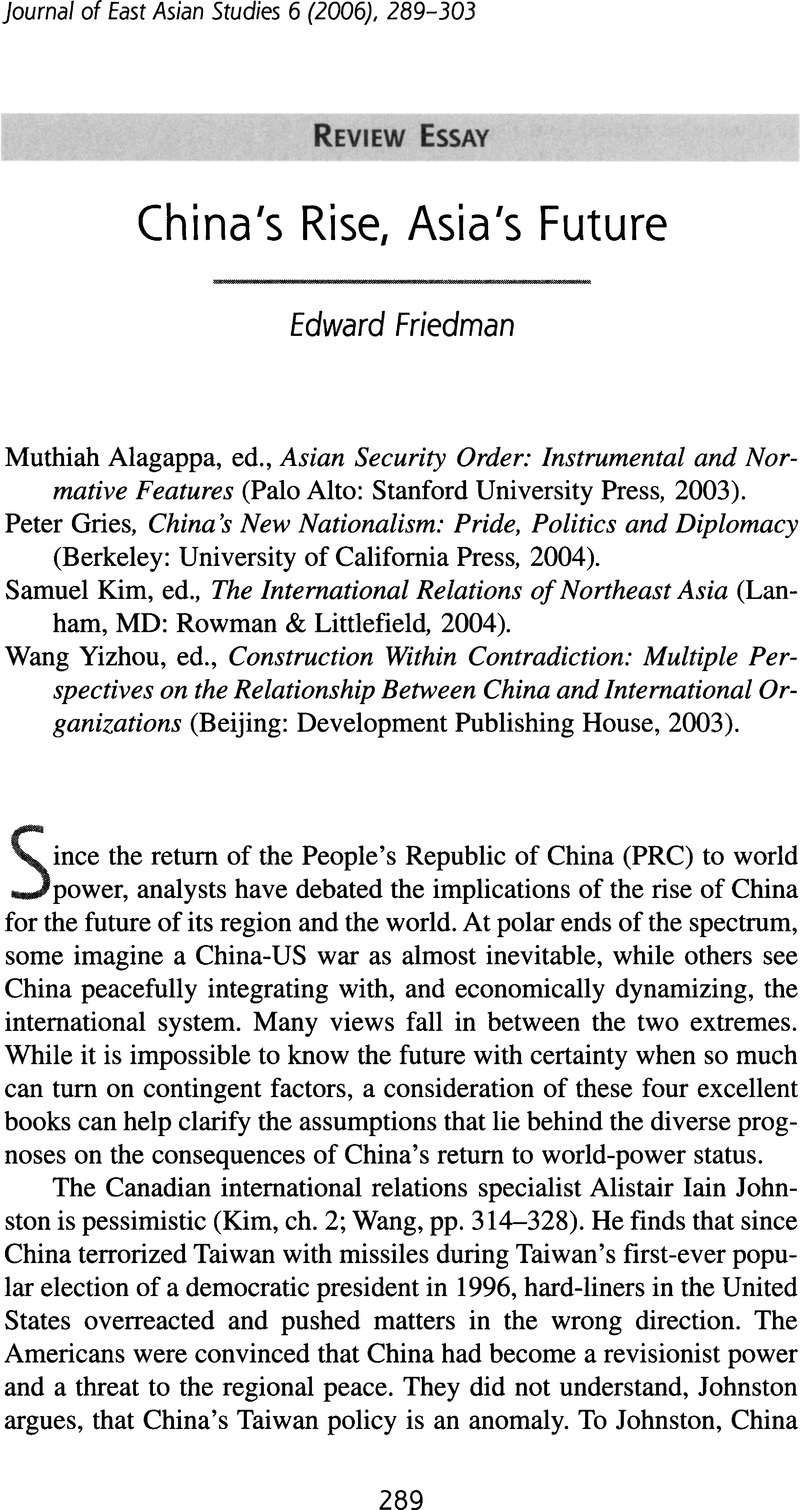No CrossRef data available.
Article contents
China's Rise, Asia's Future - Edward Friedman and Muthiah Alagappa, ed., Asian Security Order: Instrumental and Normative Features (Palo Alto: Stanford University Press, 2003). - Peter Gries China's New Nationalism: Pride, Politics and Diplomacy (Berkeley: University of California Press, 2004). - Samuel Kim, ed. The International Relations of Northeast Asia (Lanham, MD: Rowman & Littlefield, 2004). - Wang Yizhou, ed. Construction Within Contradiction: Multiple Perspectives on the Relationship Between China and International Organizations (Beijing: Development Publishing House, 2003).
Published online by Cambridge University Press: 24 March 2016
Abstract

- Type
- Review Essay
- Information
- Copyright
- Copyright © East Asia Institute
References
Notes
1. Cf. Johnston, Alistair Iain, “Beijing's Security Behavior in the Asia-Pacific.” In Suh, J. J. et al., eds., Rethinking Security in East Asia (Stanford: Stanford University Press, 2004), ch. 2.Google Scholar
2. For details on China's post–June 4 reconstruction of its nationalism, see Guo, Yingjie, Cultural Nationalism in Contemporary China (New York: RoutledgeCurzon, 2004), pp. 52, 62, 73, 97, 125.CrossRefGoogle Scholar
3. For realist critiques of the Alagappa approach, see “Book Review Roundtable,” Issues and Studies 41, No. 1 March 2005): 219–250. In contrast to Gries, Alagappa does not see a deterioration of China-Japan relations. “China is improving its relations with Japan” (Alagappa, p. 97).Google Scholar
4. This Sinocentrism is not new. Diplomatic historian Chen Jian details how in China's entering the Korean War in 1950, “Beijing's mentality [was] … penetrated by the “Central Kingdom's sense of moral superiority.” Mao dispatched Chinese troops into Korea for “achieving the Korean Communists' inner acceptance of China's morally superior position”' (Jian, Chen, “Limits of the ‘Lips and Teeth’ Alliance,” Asia Program Special Report, University of Virginia, n.d., p. 5).Google Scholar
5. Guo, , Cultural Nationalism in Contemporary China, p. 128.Google Scholar
6. Kissinger, Henry, “China Shifts Centre of Gravity,” The Australian, June 13, 2005.Google Scholar
7. For histories of China's actual expansion by force, see Di Cosmo, Nicola, Ancient China and Its Enemies (New York: Cambridge University Press, 2002); Johnston, Alistair Iain, Cultural Realism (Princeton: Princeton University Press, 1995); and Perdue, Peter, China Marches West (Cambridge: Belknap/Harvard University Press, 2005). On the war-prone basis of Chinese strategic conceptualization, see Gawlkowski, Krzysztof, “Three Approaches to War and Struggle in Chinese Classical Thought.” In Krieger, Silke and Trauzettel, Rolf, eds., Confucianism and the Modernization of China (Mainz: Hase & Koehler, 1991), pp. 367–373.CrossRefGoogle Scholar
8. Sukma, Rizal, “Indonesia's Perceptions of China.” In Yee, Herbert and Story, Ian, eds., The China Threat: Perceptions, Myths and Realities (New York: RoutledgeCurzon, 2002), p. 189.Google Scholar
9. Wade, Geoff, The Zheng He Voyages, National University of Singapore, Asia Research Institute Working Paper Series No. 31, October 2004, pp. 6, 9, 11, 18.Google Scholar
10. See Cabestan, Jean-Pierre, “The Chinese Factor.” In Boquerat, Gilles and Grave, Frederic, eds., India, China, Russia (Singapore: India Research Press, 2004), ch. 4.Google Scholar
11. “China is determined to deter Taiwan from declaring independence” (Cohen, Roger, “Shaping China's Future Power,” New York Times, June 12, 2005); “Taiwan must be pressed not to take unilateral steps that would be tantamount to independence, and risk a military response from the mainland” (Haas, Richard, “What to Do About China,” U.S. News and World Report, June 20, 2005); “Taiwan is part of China” (Henry Kissinger, “Conflict Is Not an Option,” International Herald Tribune, June 9, 2005).Google Scholar
12. The huge positive contribution of Taiwan to China's growth is almost invisible even to open-minded Chinese (Wang, , pp. 143, 149), because CCP counting practices excluded the Taiwan trade and Taiwan's capital entering China from Hong Kong.Google Scholar
13. Wachman, Alan, Why Taiwan? (Stanford: Stanford University Press, 2006).Google Scholar
14. Michael Mastanduno describes US policy as “comprehensive engagement with China” “to integrate China in the present order” (Alagappa, pp. 162, 143).Google Scholar
15. “Japan has adroitly promoted regional multilateralism,” Job notes (Alagappa, p. 252). Japan, Calder tells us, “is the real colossus of Northeast Asia” (Kim, p. 241). Ming Wan adds, “Japan has the most developed strategy of economic cooperation in the region”; Japan is the “largest aid donor to East Asia,” including to China (Alagappa, pp. 286, 287). Shen Jiru agrees on Japan's contribution to multilateral regional cooperation (Wang, p. 137).Google Scholar
16. “Others, like France, consider Mongolia to be in China's sphere” (Tkacik, John Jr., “Asia's Outpost of Democracy,” Far Eastern Economic Review, June 2005: 21).Google Scholar




